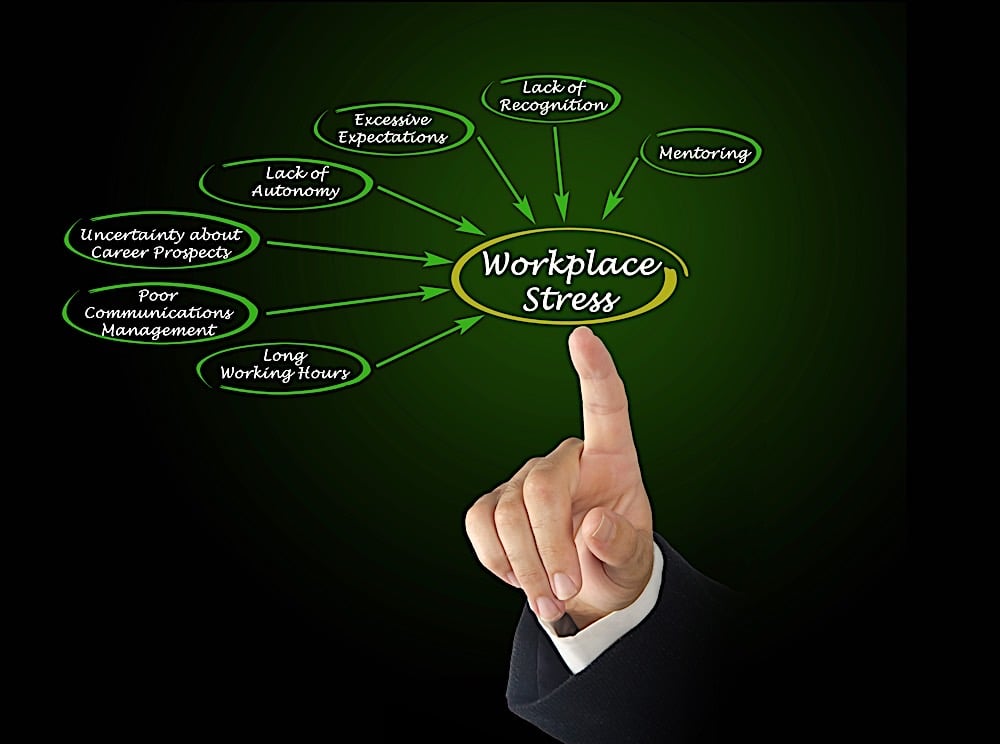
Stress in 2023: This Year’s Unique Workplace Stress Factors Due to Recession, Post-Covid and Other Factors
The workplace environment is changing rapidly. Workplace stress has taken a toll on many employees leading to mental and physical health issues. This report outlines recent findings about unique workplace stress factors affecting workers in 2023.
The vast majority of workers report experiencing stress. According to a survey carried out on May 10, 2023, 92% of white-collar employees are financially stressed. This, in turn, has led to adverse effects on their physical health by 60% and mental health by 72%. [1]
Factors Leading to Workplace Stress
Stress in the workplace doesn’t come from one source. There are different contributing factors, which can be seen below.

Finances
According to Marthin De Beer, founder and chief executive officer of BrightPlan, “The impact of financial stress on people’s mental and physical health is well established, but few studies have examined how this can affect our relationships and social health.”
Therefore, he urges employers to understand that workers’ financial stress affects their general well-being, including their work engagement and performance.

Inflation
In BrightPlan’s survey above, respondents claimed that inflation ranks highest (96%) out of all sources of financial stress they experience. Similarly, a survey by Ciphr that polled senior managers and leaders found that high inflation and rising prices are the second leading (29%) cause of job stress among workers.
When inflation is high, it can be difficult for people to meet their basic needs such as:
- healthcare
- food
- housing
This is consistent with a survey carried out by the American Psychiatric Association (APA), which demonstrated that about 90% of Americans felt anxious regarding inflation. [2] [3]
Recession
The recession may contribute to an increase in job insecurity. Some employees may worry about layoffs, downsizing, or job stability. Boosting employee morale and ensuring job security are two essential tasks for employers.
What can be offered to achieve high morale in the workplace? The following might help:
- Job security guarantees
- Training
- Development opportunities
- Creating an environment of trust and transparency
Organizations may undergo workforce restructuring in response to the recession, including reorganizations, mergers and acquisitions. These changes can cause stress in employees, whether changing their job roles, increasing their workloads, or requiring them to learn new skills quickly.
Economic downturns have frequently resulted in cost-cutting measures and budget constraints. As a result, employees have been under greater pressure to fulfill performance targets with fewer resources or financial limits, contributing to stress and a perception of overwork.

Remote work complications
Remote and hybrid work arrangements have grown increasingly common since the COVID-19 epidemic. In a survey by Robert Half Canada, researchers have found the following:
- 36% of working mothers in Canada were willing to accept a salary reduction as long as their working arrangement was switched to remote working. [4]
“It’s clear that flexibility is of paramount priority for working moms and offering this is a major way companies can support mothers in their workforce, as it allows them to balance their professional responsibilities with their parenting commitments in a meaningful way,” Regional Director Sandra Lavoy at Robert Half has observed.
On the other hand, a survey by Capterra Inc. reported that 65% of working mothers had undergone strain to their mental health and stress while trying to balance their family and work responsibilities. [5]

Burnout and fatigue
The ongoing pandemic and economic instability can create an environment where employees feel driven to work longer, take on new duties, or demonstrate value. This might result in burnout and tiredness, which can severely impact one’s mental health and overall well-being.
Concerns concerning workplace health and safety
Despite the widespread distribution of COVID-19 vaccinations, there may still be concerns about workplace health and safety.
According to this study, 37% of the workers were still anxious and concerned about COVID-19 exposures and related issues such as infection rates despite surviving the pandemic for the last three years. [6]
Market volatility
With the predicted volatility in commodity markets, companies will likely experience financial challenges or downsizing. This can lead to layoffs, job losses, or reduced work hours. The fear of losing one’s job or facing an uncertain future can create immense stress among employees. [7]

Effects of Workplace Stress
According to Mary McGeady, a senior HR consultant at WorkNest, employers should not ignore workplace stress. If not addressed, “they will result in significant workplace stress and poor retention that can affect the company’s reputation and expose significant risks to the business,” she mentioned. [8]
Workplace stress can significantly impact various aspects of a person’s life. Here are some of them:
Effects on well-being
● Strained relationships
Chronic work-related stress can lead to strained relationships with family, friends, and coworkers. When individuals are overwhelmed and exhausted by their work, they may have less energy and time to invest in maintaining healthy social connections. This can lead to feelings of isolation and a lack of support from loved ones.
● Reduced social engagement
Increased stress at work can diminish an individual’s motivation and ability to engage in social activities outside work. They may withdraw from social events, hobbies, and other leisure activities they once enjoyed, further isolating themselves and missing out on opportunities for social interaction and personal growth.
● Communication difficulties
Stress can negatively impact communication skills, making it challenging to express thoughts and emotions effectively. This can result in misunderstandings, conflicts, and strained communication with coworkers and loved ones. The inability to communicate well can further exacerbate stress and hinder the development of meaningful relationships.
● Decreased work-life balance
Excessive workplace stress can disrupt the work-life balance, leading to increased time spent at work and reduced time for personal activities and socializing. This imbalance can create dissatisfaction and resentment, affecting relationships and overall social well-being.
● Emotional well-being
Workplace stress can also have a significant impact on emotional well-being, leading to increased irritability, mood swings, anxiety, and depression. These emotional challenges can strain social relationships, as individuals may struggle to manage their emotions and interact positively with others.
● Burnout and withdrawal
Prolonged exposure to high levels of work-related stress can lead to burnout, a state of chronic physical and emotional exhaustion. Burnout often results in withdrawal from social interactions and a decreased desire to engage with others. This withdrawal can contribute to loneliness and further hinder social well-being. A study found that remote and hybrid working could help reduce burnout and enhance work-life balance.
● Negative health effects
Persistent workplace stress can harm physical health leading to issues such as cardiovascular problems or compromised immune functions. These can limit a person’s ability to participate in social activities and may require them to prioritize self-care over social interactions.
On Productivity and Engagement at Work
Stress can cause employees to have a low level of engagement and a lack of focus at work. These in turn lead to decreased productivity and even lateness and absences.
● Decreased focus
When employees are stressed, their ability to concentrate and focus on tasks diminishes. They may find it challenging to prioritize and complete their work efficiently.
● Reduced energy and motivation
Stress can drain energy levels and reduce motivation, making it harder for employees to maintain productivity. They may feel overwhelmed or see little future hope, leading to procrastination and delays.
● Poor decision-making
Stress impairs cognitive functioning, including decision-making abilities. Employees may struggle to make sound judgments, resulting in errors or suboptimal choices. This can ultimately lead to accidents or lost clients.
● Increased absenteeism
Chronic stress can lead to physical and mental health issues, causing employees to take more sick days and exhibit declining productivity.
● Decreased job satisfaction
Persistent stress can erode job satisfaction and engagement. Employees may feel disenchanted with their work and disconnected from the organization’s goals.
● Lowered morale
Stress can create a negative work environment, affecting team dynamics and morale. It can lead to conflicts, strained relationships, and decreased collaboration.
● Reduced initiative and creativity
When individuals are stressed, their ability to generate innovative ideas can be stifled. They may become more risk-averse and hesitant to contribute.
● Increased turnover
Prolonged work stress can contribute to high employee turnover. Dissatisfied and stressed employees are more likely to seek opportunities elsewhere, impacting engagement and productivity while they look and depleting the team of valuable skills when they leave.
How to Combat Workplace Stress
Individuals and organizations must recognize and address workplace stress early. Employers can implement measures to reduce stress levels with the following:
- Promote a healthy work-life balance.
- Provide resources for stress management such as stress-management webinars, mindfulness/yoga training, subsidize gym memberships
- Foster a positive work environment.
- Offering employee support programs.
Individuals can also take steps to manage workplace stress for themselves, such as setting boundaries, practicing self-care, seeking social support, and engaging in stress-reducing activities outside of work such as sports.
Key Takeaways: Mitigating Unique Stress Factors in a Workplace
To mitigate the harmful effects of work stress on productivity and engagement, organizations can:
- Foster a supportive and inclusive work culture that promotes work-life balance and well-being.
- Encourage open communication and provide avenues for employees to express concerns or seek help.
- Offer stress management programs, such as mindfulness training, resilience workshops, or counselling services.
- Provide clear expectations, achievable goals, and resources for employees to succeed.
- Promote autonomy and decision-making authority to empower employees.
- Recognize and reward achievements to boost motivation and engagement.
- Regularly assess workload and redistribute tasks if necessary.
- Encourage breaks and time off to prevent burnout.
By addressing work stress proactively, organizations can improve productivity and engagement while fostering a healthier work environment.
References
- Benefits Canada. “92% of white-collar workers say they’re financially stressed: Survey”
- CIPHR. “Causes of stress at work- survey results.”
- GoodTherapy. “Mental Health and Inflation: Understanding the Impact.”
- Benefits Canada. “36% of working moms are willing to take a pay cut in exchange for remote work: A Survey”
- Benefits Canada. “Majority of Canadian working moms struggling with work-life balance: A Survey”
- AJ HESS. “These are workers’ biggest fears about 2023”
- Mohommad A., Raissi M., Lee K. and Fizzarotti, C. “Volatile Commodity Prices Reduce Growth and Amplify Swings in Inflation: Resurgent volatility in commodity markets will likely pose economic challenges in coming years even as prices decline”
- Cholteeva, Y. “Three in five employees feel stressed at work because of the cost of living, study finds”
- Benefits Canada. “Just 43% of global employees say they can choose where they work: A Survey”


 Our HR solutions experts can recommend the right mix of HR outsourced services to make your entry into Canada easier.
Our HR solutions experts can recommend the right mix of HR outsourced services to make your entry into Canada easier.  Pivotal Employment Management Services co-hires your workforce, simplifying entry of your business in Canada.
Pivotal Employment Management Services co-hires your workforce, simplifying entry of your business in Canada. 
















How To Not Get the Job